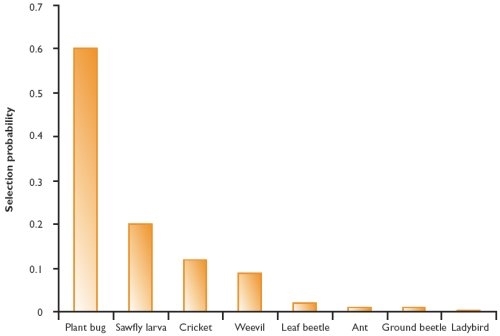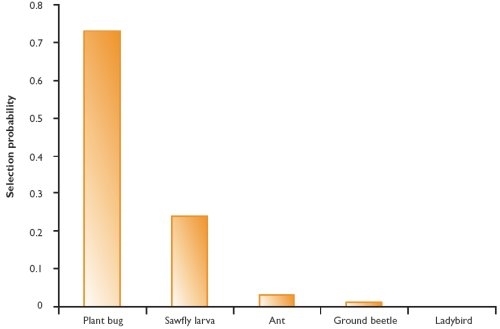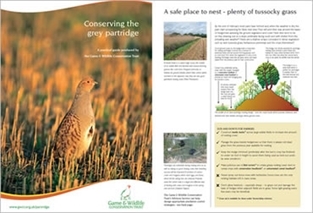Key findings
- Insect choice was primarily influenced by size and colour.
- For similarly sized items, green/yellow was preferred over brown/black.
- Larger items were selected preferentially over small ones.
- Red items were least selected.
Studies on bird diet using gut and faecal samples have shown what birds eat, but not necessarily what they prefer. To understand this choice of food, we fed 100 partridge chicks, grouped into threes, pairs of differently sized and coloured insects or coloured food pellets, to see if food choice was related to size, colour or movement.
The trial involved seven insect groups that partridges normally eat (see Table 1) along with one that they do not (seven-spot ladybird). We offered over 4,000 pairs of insects to the chicks and over 900 insects were eaten.
Table 1: Insect food offered to grey partridge chicks
| Insect type (taxon) |
Size (mm) |
Colour |
| Sawfly larva (Hymenoptera: Symphyta) |
15-20 |
light green-buff |
| Cricket (Orthoptera: Gryllidae) |
10-12 |
light brown-buff |
| Plant bug (Heteroptera: Miridae) |
4-5 |
light yellow-green |
| Leaf beetle (Coleoptera: Chrysomelidae) |
4-5 |
blue/orange |
| Seven-spot ladybird (Coleoptera: Coccinellidae) |
6-7 |
red/black |
| Weevil (Coleoptera: Curculionidae) |
4-5 |
green |
| Ant (Hymenoptera: Formicidae) |
4-5 |
brown |
| Small ground beetle (Coleoptera: Carabidae) |
4-5 |
black |
First we fed the groups of chicks pairs of all eight insect groups, placing the food on various coloured backgrounds. The chicks selected green-yellow plant bugs over the much larger green-buff sawfly larvae or buff-coloured crickets. Chicks chose all these large items in preference to the smaller dark-coloured insects. They selected red ladybirds least (see Figure 1).
Figure 1: Grey partridge chick preference for food items provided dead (still)

Having found that size and colour both influenced food selection, we wanted to find out what part movement played in choice. We used live insects from five of the groups, two that were preferred in the previous tests (plant bugs and sawfly larvae) and three less chosen ones (ground beetles, ants and ladybirds). Again chicks selected the two larger items in preference to the more active but smaller and dark-coloured ants and beetles and again they chose the large red ladybird least (see Figure 2).
Figure 2: Grey partridge chick preference for food items provided alive (moving)

To see how colour only influenced choice we used commercial chick pellets dyed one of seven colours, green, brown, yellow, black, red, blue and natural (buff). Needing the comparisons to be 'realistic', we measured the exact colours of the insects used previously and compared them with the coloured pellets. The colours of the insects and correspondingly coloured pellets were similar in most cases. Green and yellow again ranked highly in the chicks' preferences.
Our trial results generally agreed with findings from gut and faecal studies. However, in the field the chicks may find that their preferred larger green-yellow food items are more difficult to detect especially if immobile on vegetation. Such items may also be above foraging height, so choice may be restricted to the smaller, often active, but less preferred items on the ground or on lower vegetation.
In cereal crops, a partridge chick may have little choice between different food types, needing to consume all available items, unless weed patches provide insects in excess allowing chicks to be more selective. Moreover, if feeding time is limited by inclement weather or insect abundance reduced by pesticides, then chicks are likely to consume all suitable items.
Further reading
- Moreby, S.J., Aebischer, N.J., & Southway, S.E. 2006. Food preferences of grey partridge chicks, Perdix perdix, in relation to size, colour and movement of insect prey. Animal Behaviour, 71: 871-878.
- Ewald, J.A. & Aebischer, N.J. 1999. Pesticide Use, Avian Food Resources and Bird Densities in Sussex. JNCC Report No. 296, Joint Nature Conservation Committee, Peterborough.
- Aebischer, N.J. 1991. Twenty years of monitoring invertebrates and weeds in cereal fields in Sussex. In: Firbank, L.G., Carter, N., Darbyshire, J.F. & Potts, G.R. (eds) The Ecology of Temperate Cereal Fields: 305-331. Blackwell Scientific Publications, Oxford.
Get your FREE Grey Partridge Conservation Guide
An essential guide to conserving the grey partridge produced by the Game & Wildlife Conservation Trust.
What's inside your FREE guide
✓ The decline of a common farmland bird
✓ A safe place to nest - plenty of tussocky grass
✓ Chick survival - insect food is crucial
✓ Surviving winter and spring - food and cover
✓ Conservation targets - Partridge Count Scheme
✓ Grey partridges and shooting
✓ Common questions
Download guide now >